State of Charge
Charging Station Reviews
We independently review every item we recommend. If you buy through our links, we may earn a small commission that helps us continue to make quality content for you. Thanks for your support!
Webasto Go Portable Dual Voltage EV Charging Station Review
Considering that the demand for portable and dual-voltage EVSEs continues to go up, we just had to review this one.
Table of Contents:
Dual-voltage portable chargers have become much more mainstream in recent years, with quite a few options available in today’s market. On the one hand, it’s great to have a lot of choices. But on the other hand, many of those choices haven’t proven to be particularly good ones, with cheap, unreliable products hitting retailers everywhere. It hasn’t been easy to find a portable EV charger that you can trust to work for very long.
Enter the Webasto Go, a portable, dual-voltage EVSE from a well-established manufacturer based in Germany that is both of good quality and safety certified. In fact, Wabasto even boasts of being the preferred charging solution for top automakers like Ford, BMW, Chevrolet, Volvo, Lincoln, Fiat, Kia, and Mitsubishi, providing the standard portable chargers for cars like the Volkswagen ID.4, the Ford Mustang Mach-E, and the Ford F-150 Lightning. That’s a pretty impressive resume at first glance. But will it hold up under my rigorous testing? Let’s find out.
Key Specs of the Webasto Go
Like any other portable charger, the Webasto Go is a plug-in device intended to be used on the go; it even comes with a handy carrying case for that very purpose. Inside the case, you will find the unit and its charging cable with its J1772 connector, a mounting cradle, a NEMA 5-15 adapter, a NEMA 14-50 adapter, a rudimentary installation guide, and a couple of screws. There weren’t any drywall anchors included, which I found a little weird– you’ll want those to create a stronger attachment to the wall if you don’t have a convenient stud. With everything in the bag, you can bring this EVSE along in your vehicle for whenever you need to top-up your power.
If you prefer to mount it in a more permanent location so the Webasto Go isn’t just dangling from an outlet, you can definitely do that, too. The mounting bracket that comes with the unit has a couple of pre-drilled holes to attach it to the wall (preferably over a stud for extra stability). If you don’t have a stud, make sure to find a couple of drywall anchors so you’re less likely to rip the screws out of the wall during everyday use. After screwing the bracket to the wall at your preferred location, the Webasto Go will just snap right into place.
It is worth pointing out that the Webasto Go doesn’t come with any sort of connector holster or cable management system. If you do want to invest in an inexpensive accessory to manage your charging cable, I’d recommend checking out this Lectron dock and hook combo – I use it frequently with my EV charging stations.
Since the Webasto Go is a dual-voltage EVSE, you’ve got two different charging possibilities to work with. The first is the Level 1 option, which allows you to charge at 12 amps through a 120-volt connection. This delivers up to 1.4 kW of power to your EV via the included NEMA 5-15 adapter.
The second is the Level 2 option, which allows you to charge at 32 amps through a 240-volt connection. This delivers up to 7.7 kW of power via the included NEMA 14-50 adapter. Depending on your vehicle’s efficiency, you may be able to get around 30 miles of range per hour charged using this option.
Since this unit comes with a J1772 connector, the Webasto Go can be used to charge any North American EV (including Teslas, which now include a J1772 adapter with every vehicle they sell). The Go’s charging cable is 20 feet long– not the longest on the market, but it’ll do the job. Webasto advertises this portable EVSe as being designed with features like thermal detection, auto-restart and recovery, and ground detection against faults. It also claims that the Go has a NEMA 6P watertight rating, meaning that the unit should be able to withstand being submerged in 3 feet of water for at least 30 minutes without leakage (more on my findings in the Testing section below). In addition, the Webasto Go has been UL and cUL certified for safety, which is an unusual but welcome contrast from most other portable EV chargers.
Testing
I used the Webasto Go over several weeks to charge a Tesla Model 3, a Ford F-150 Lightning, a Rivien R1S, and a Ford Mustang Mach-E, all so I could see how the device held up during regular use. I also tested it under some more extreme conditions that users might occasionally face out in the wild. Why? Because buying an expensive EV charging station can become a huge headache if it turns out to be of poor quality or doesn’t meet all your charging needs. I’m dealing with those hassles so you don’t have to. So how well did the Go hold up?
The Automatic Restart Test
For this test, I simulate a power outage by plugging the charger into a vehicle and then cycling the circuit breaker off and on again. The goal is to see if the EV charging station will relaunch the charging cycle without user input. The last thing you want to do is wake up one morning with the expectation that your EV will be charged and ready to go, only to find that your EVSE didn’t resume charging after temporarily losing power. The Webasto Go worked fine and immediately started charging again once power was restored.
The Cable Deep Freeze Test
Some of us live in cold climates where having an EV charging station that can withstand frigid temperatures is an absolute must. You also need a charging cable that can remain flexible even in subzero temperatures. In order to test how well the Webasto Go would do in similar conditions, I coiled up its cable and put the whole unit into a commercial ice cream freezer for 24 hours. Before pulling it out again, I measured the interior temperature at a glacial -15.5° F (-26.39° C).
After snapping the unit back into its mounting bracket, I unwound the charging cable. While it isn’t a very bendable cable, it’s thin enough that you can just overpower it and force it to bend in the direction you want. It’s not fantastic, but it’s still pretty good, and it’s definitely a pass for the cable deep freeze test.
The Connector Drop Test
Connectors get dropped; it’s just a fact of life. What you want is a charging station with a connector that can handle rough treatment without cracking or breaking. I tested the Webasto Go portable dual-voltage EVSE by dropping the connector from about chest height to the concrete floor of my garage five times in a row. This unit handled the abuse without a bit of damage, which is what I want to see from a portable charger.
The Charger Drop Test
Now, since this is a portable charger, it felt natural to make a case for doing the same drop test with the charging unit itself; you’ll be taking it in and out of your car for use, and it’s bound to end up on the pavement once in a while. I’m going to start doing this test with all of the portable chargers I review going forward, as a matter of fact. So the Webasto Go got the honor of being the first charger I tested in such a manner.
Five drops later, and the Go started up and charged an EV without any issues. The plastic casing is really robust and is protected by a rubberized casing around the corners, which does a great job shielding the unit from drops like this.
The Submersion Test
Last but not least came the submersion test, where I test to see if a device really lives up to its weatherproof rating. The Webasto Go does have a NEMA 6P watertight rating, meaning that it's waterproof, not just water resistant, and it should be able to be submerged in up to three feet of water for up to 30 minutes. My test involves dumping the unit into a bucket of water and letting it charge my EV for half an hour.
Those of you who follow me may have seen the last review I did of a portable charger, which failed spectacularly at this test in spite of a very similar waterproof rating. That wouldn’t happen again, right?
Wrong. Almost immediately after becoming submerged, I could see bubbles coming out from where the adapter attaches to the unit, and the unit’s indicator lights went red to indicate a fault. I didn’t even have time to plug it into a vehicle before it stopped working. After opening it up, I could see that water had penetrated the seal. The good news is that, after letting the unit dry out, the Webasto Go did work fine and did manage to charge my Rivian R1S, unlike the Pergear P2, which was totally fried.
Some folks may think I’m being a little hard on these companies by literally dumping these units into a bucket of water, but if it's rated to be able to withstand that, it should be able to withstand that. Either something is wrong with the specific unit that I tested, or the product isn’t quite as watertight as it should be.
Since not everything about a rating can be nailed down on a chart, I also like to give the products I review my own personal score. I gave the Go 4.45 stars because I really like this unit; it’s a great portable charging station, even if I can’t dunk it into a bucket of water. After combining and averaging these scores, I gave the Webasto Go a final score of 4.4 stars. It’s expensive, and the warranty leaves something to be desired, but it’s also a solid portable EV charging station that beats most of the others on the market today,
The Webasto Go dual-voltage portable EV charger is currently available for $549 on Amazon. Check out my full review in the video above, and I’d love to hear your thoughts in the comments down below.

By: Tom Moloughney
YOU MIGHT ALSO BE INTERESTED IN:


EVChargingStation’s Comment Policy
We welcome polite, respectful comments, but rudeness and personal attacks will not be tolerated. All comments are reviewed prior to publication. Thanks for joining in the conversation!

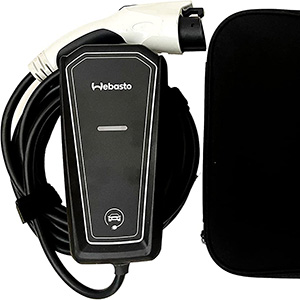
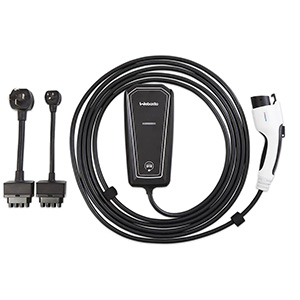
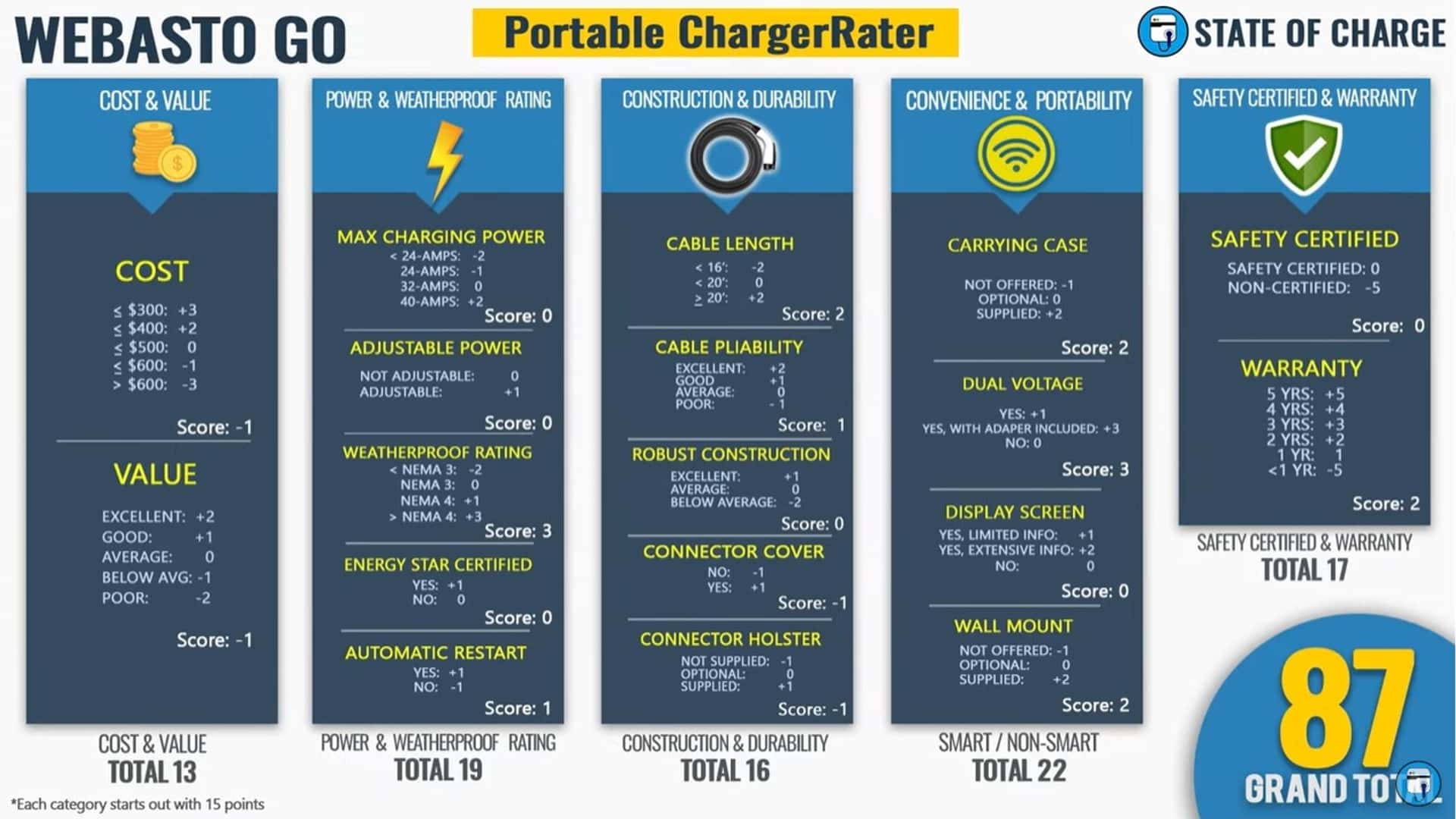
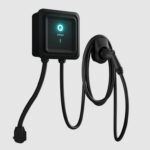

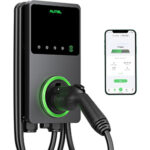

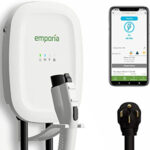

0 Comments